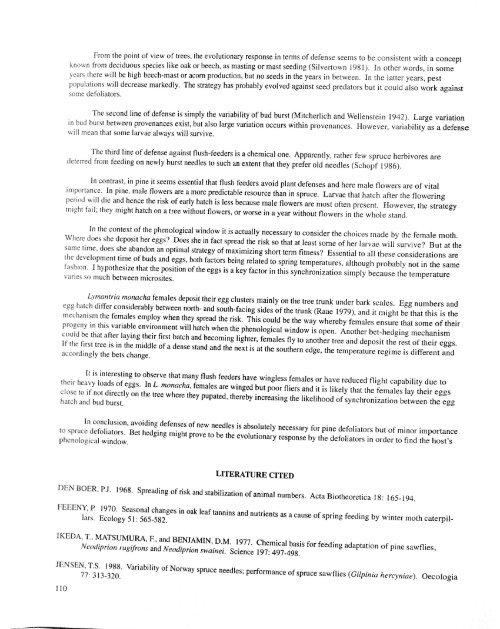View or print this publication - Northern Research Station - USDA ...
View or print this publication - Northern Research Station - USDA ...
View or print this publication - Northern Research Station - USDA ...
You also want an ePaper? Increase the reach of your titles
YUMPU automatically turns print PDFs into web optimized ePapers that Google loves.
From the point of view of trees, the evolutionary response in terms of defense seems to be consistent with a concept<br />
k_own from deciduous species like oak <strong>or</strong> beech, as masting <strong>or</strong> mast seeding (Silvertown 1981). tn other w<strong>or</strong>ds, in some<br />
years there will be high beech-mast <strong>or</strong> ac<strong>or</strong>n production, but no seeds in the years in between. In the latter years, pest<br />
populations will decrease markedly. The strategy has probably evolved against seed predat<strong>or</strong>s but it could also w<strong>or</strong>k against<br />
_omedefoliat<strong>or</strong>s.<br />
The second line of defense is simply the variability of bud burst (Mitcherlich and Wellenstein 1942). Large variation<br />
in bud burst between provenances exist, but also large variation occurs within provenances. However, variability as a defense<br />
will mean that some larvae always will survive.<br />
The third line of defense against flush-feeders is a chemical one. Apparently, rather few spruce herbiv<strong>or</strong>es are<br />
deterred from feeding on newly burst needles to such an extent that they prefer old needles (Schopf 1986).<br />
In contrast, in pine it seems essential that flush feeders avoid plant defenses and here male flowers are of vitae<br />
imp<strong>or</strong>tance. In pine, male flowers are a m<strong>or</strong>e predictable resource than in spruce. Larvae that hatch after the flowering<br />
period will die and hence the risk of early hatch is less because male flowers are most often present. However, the strategy<br />
might fail; they might hatch on a tree without flowers, <strong>or</strong> w<strong>or</strong>se in a year without flowers in the whole stand.<br />
In the context of the phenological window it is actually necessary to consider the choices made by the female moth.<br />
Where does she deposit her eggs? Does she in fact spread the risk so that at least some of her larvae will survive? But at the<br />
same _ime,does she abandon an optimal strategy of maximizing sh<strong>or</strong>t term fitness? Essential to all these considerations are<br />
_hedevelopment time of buds and eggs, both fact<strong>or</strong>s being related to spring temperatures, although probably not in the same<br />
fashioa. I hypothesize that the position of the eggs is a key fact<strong>or</strong> in <strong>this</strong> synchronization simply because the temperature<br />
varies so much between microsites.<br />
1#mantria monacha females deposit their egg clusters mainly on the tree trunk under bark scales. Egg numbers and<br />
egg hatch differ consideraNy between n<strong>or</strong>th- and south-facing sides of the trunk (Raae 1979), and it might be that <strong>this</strong> is the<br />
mechanism the females employ when they spread the risk. This could be the way whereby females ensure that some of their<br />
progeny in <strong>this</strong> variable environment will hatch when the phenological window is open. Another bet-hedging mechanism<br />
couid be that after laying their first batch and becoming lighter, females fly to another tree and deposit the rest of their eggs.<br />
If the first tree is in the middle of a dense stand and the next is at the southern edge, the temperature regime is different and<br />
acc<strong>or</strong>dingly the bets change.<br />
litis interesting to observe that many flush feeders have wingless females <strong>or</strong> have reduced flight capability due to<br />
their heavy loads of eggs. In L monacha, females are winged but po<strong>or</strong> fliers and it is likely that the females lay their eggs<br />
close to if not directly on the tree where they pupated, thereby increasing the likelihood of synchronization between the egg<br />
i_atchand bud burst.<br />
In conclusion, avoiding defenses of new needles is absolutely necessary f<strong>or</strong> pine defoliat<strong>or</strong>s but of min<strong>or</strong> imp<strong>or</strong>tance<br />
_o spruce de_bliat<strong>or</strong>s. Bet hedging might prove to be the evolutionary response by the defoliat<strong>or</strong>s in <strong>or</strong>der to find the host's<br />
phenological window.<br />
LITERATURE CITED<br />
DEN BOER, RJ. 1968. Spreading of risk and stabilization of animal numbers. Acta Biothe<strong>or</strong>etica 18:165-194.<br />
FEEENY, P 1970. Seasonal changes in oak leaf tannins and nutrients as a cause of spring feeding by winter moth caterpillars.<br />
Ecology 51' 565-582.<br />
KEDA, T., MATSUMURA, E, and BENJAMIN, D.M. 1977. Chemical basis f<strong>or</strong> feeding adaptation of pine sawflies,<br />
,_e_:dlpr_on rug(fr<strong>or</strong>ls and Neodiprion swainei. Science 197: 497-498.<br />
JENSEN, T.S. 1988. Variability of N<strong>or</strong>way spruce needles; perf<strong>or</strong>mance of spruce sawflies (Gilpinia hercyniae). Oecologia<br />
77:313-32(t.
















